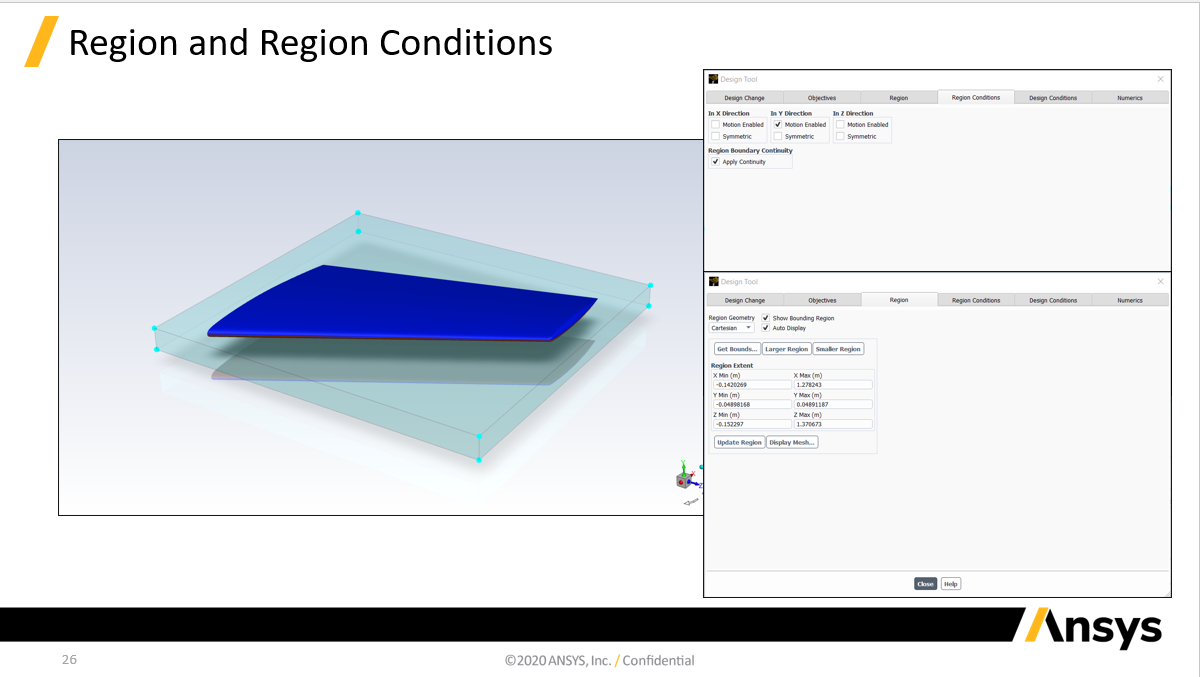-
-
April 13, 2023 at 2:02 pm
Aras karimi
SubscriberHello everyone,
I am quite stuck in the adjoint solver. How can optimize the wing without changing the airfoil chord while doing the 3D wing optimization in the adjoint solver ?
I have already checked the 'design conditions' tab in adjoint solver options. But I am not sure how to use them to get it done.
Thanks in advance.
-
April 14, 2023 at 12:04 pm
Murari Iyengar
Ansys EmployeeYou can use Fixed-Walls-Constraint or Rigid-Body depending on your application. You can find more information about Design Conditions here: 43.2. Using the Adjoint Solver (ansys.com)
-
April 14, 2023 at 12:35 pm
Nikhil N
SubscriberIf you are not able to access the link, please refer to this forum discussion: How to access the ANSYS Online Help
-
September 21, 2023 at 3:23 pm
Murari Iyengar
Ansys EmployeeOne way you can do this is to orient the wing so that the zero angle of attack orientation is aligned with the x-z plane and the only allow y motion when you calculated the design condition. This is illustrated in the slide below. This wouldn't constrain the camber line but then is that desirable? If the camber needs to be preserved, then all you can really do is try to optimize the thickness distribution about the camber line. This would be challenging in 3D.
-
September 22, 2023 at 9:02 am
Aras karimi
SubscriberThank you for your answer.
1) Is it possible to constraint the movement of the wing in X and Z directions in other angles of attack or can this be done only in the angle of attack of zero degrees?
2) If I want to keep the camber line during optimization, how can I do this?
-
September 24, 2023 at 5:44 am
Aras karimi
SubscriberHi Dear Murari,
I followed your suggestion exactly and constraint the movement of the wing in x and z directions. I used the ’Radial Basis Function' morphing method and considered the size of the adjoint box as its default.
After performing the optimization at the angle of attack 7 degrees using the gradient based optimizer, the optimizer stopped automatically and had optimized the geometry sixty times. According to the figure below, the final geometry has a very deformed TE, which is no longer a wing:
What should I do to solve this problem? Are there any other settings I need to apply?
Is there any other way to fix the chord length during optimization?
I used the bounded-by-surface design condition and failed.
I will be really grateful if you help me. Thankyou
Regards.
-
September 26, 2023 at 9:58 am
Aras karimi
SubscriberHello Dear Morari,
Do you have any practical examples on how to apply the fixed chord design condition?
Do you have videos or training documents on how to apply the condition of fixed chord design that you can provide me?
Dear Morari, I really don't know how to say. After six months of trying around the clock to implement this design condition, I have no more power and hope left.
I hope it helps me.
Please reply so we can find a solution for it. Thankyou Thankyou Thankyou
-
-
September 26, 2023 at 2:19 pm
Murari Iyengar
Ansys EmployeeHi, I am looking into this with my colleagues. We don't have an example but are testing it out on our end to see what settings will work best for this application. I will get back to you shortly.
-
September 30, 2023 at 8:43 pm
Aras karimi
SubscriberHi Dear Murari,
I am still waiting for the results of your investigation and your colleagues. I reminded
Did you find a solution for it?
-
October 19, 2023 at 11:11 am
Aras karimi
SubscriberHi Dear Murari,
I am still waiting for your reply. Did you find a solution for it?
-
-
- The topic ‘Fluent Adjoint Solver;constant chordline constraint’ is closed to new replies.



-
3492
-
1057
-
1051
-
965
-
942

© 2025 Copyright ANSYS, Inc. All rights reserved.








